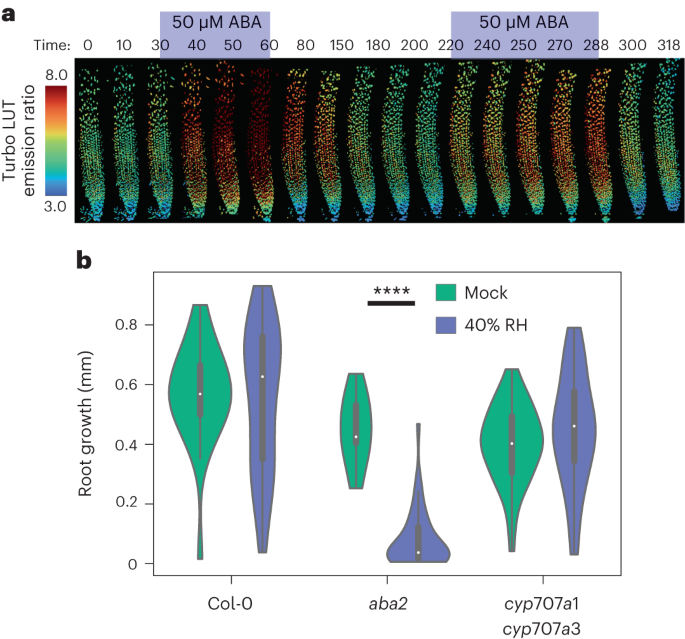Play all audios:
ABACUS2 FRET biosensors allow an unparalleled live view of the dynamics of the plant hormone abscisic acid in plants. Well-watered roots accumulate abscisic acid in growing cells when shoots
become dehydrated — a response that is essential to maintain root growth in low-humidity conditions. Access through your institution Buy or subscribe This is a preview of subscription
content, access via your institution ACCESS OPTIONS Access through your institution Access Nature and 54 other Nature Portfolio journals Get Nature+, our best-value online-access
subscription $29.99 / 30 days cancel any time Learn more Subscribe to this journal Receive 12 digital issues and online access to articles $119.00 per year only $9.92 per issue Learn more
Buy this article * Purchase on SpringerLink * Instant access to full article PDF Buy now Prices may be subject to local taxes which are calculated during checkout ADDITIONAL ACCESS OPTIONS:
* Log in * Learn about institutional subscriptions * Read our FAQs * Contact customer support REFERENCES * Jones, A. M. A new look at stress: abscisic acid patterns and dynamics at
high‐resolution. _New Phytol_ 210, 38–44 (2016). A REVIEW ARTICLE THAT DESCRIBES THE TRANSPORT, METABOLISM AND ROLE OF ABA IN STRESS RESPONSES. Article CAS PubMed Google Scholar * Jones,
A. M. et al. Abscisic acid dynamics in roots detected with genetically encoded FRET sensors. _Elife_ 3, e01741 (2014). THIS PAPER REPORTS THE FIRST GENERATION ABACUS1 SENSORS FOR ABA.
Article PubMed PubMed Central Google Scholar * Waadt, R. et al. Dual-reporting transcriptionally linked genetically encoded fluorescent indicators resolve the spatiotemporal coordination
of cytosolic abscisic acid and second messenger dynamics in arabidopsis. _Plant Cell_ 32, 2582–2601 (2020). THIS PAPER REPORTS THE ABALEONSD1-3L21 SENSOR FOR ABA. Article CAS PubMed
PubMed Central Google Scholar * Mehra, P. et al. Hydraulic flux-responsive hormone redistribution determines root branching. _Science._ 378, 762–768 (2022). THIS ARTICLE USES ABACUS2 TO
DEMONSTRATE HYDRAULIC MOVEMENT OF ABA IN ROOTS. Article CAS PubMed Google Scholar * Rizza, A. et al. Differential biosynthesis and cellular permeability explain longitudinal gibberellin
gradients in growing roots. _Proc. Natl Acad. Sci._ 118, e1921960118 (2021). THIS PAPER COMBINES MODELLING AND QUANTITATIVE EXPERIMENTS TO ESTABLISH HOW ROOT GIBBERELLIN PATTERNS ARE FORMED.
Article CAS PubMed PubMed Central Google Scholar Download references ADDITIONAL INFORMATION PUBLISHER’S NOTE Springer Nature remains neutral with regard to jurisdictional claims in
published maps and institutional affiliations. THIS IS A SUMMARY OF: Rowe, J. et al. Next-generation ABACUS biosensors reveal cellular ABA dynamics driving root growth at low aerial
humidity. _Nat. Plants_ https://doi.org/10.1038/s41477-023-01447-4 (2023). RIGHTS AND PERMISSIONS Reprints and permissions ABOUT THIS ARTICLE CITE THIS ARTICLE Visualising abscisic acid
dynamics at low humidity in planta using ABACUS2. _Nat. Plants_ 9, 1016–1017 (2023). https://doi.org/10.1038/s41477-023-01469-y Download citation * Published: 10 July 2023 * Issue Date: July
2023 * DOI: https://doi.org/10.1038/s41477-023-01469-y SHARE THIS ARTICLE Anyone you share the following link with will be able to read this content: Get shareable link Sorry, a shareable
link is not currently available for this article. Copy to clipboard Provided by the Springer Nature SharedIt content-sharing initiative

